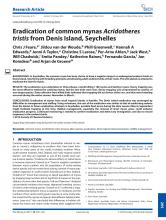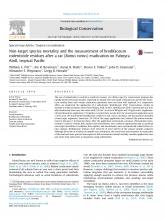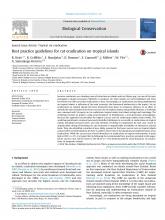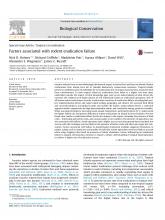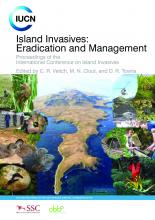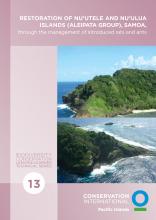Special Issue Article: Tropical rat eradicationNon-target species mortality and the measurement of brodifacoum rodenticide residues after a rat (Rattus rattus) eradication on Palmyra Atoll, tropical Pacific. Biological Conservation. Volume 185, May 2015


Island and Ocean Ecosystems, BRB
Available Online
Berentsen. A.R
,
Eisemann. J.D
,
Howaldd. G .R.
,
Pitt. W.C
,
Shiels. A.B
,
Volker. S.F
,
Wegmann. A.S
2015
The use of rodenticides to control or eradicate invasive rats (Rattus spp.) for conservation purposes has rapidly grown in the past decades, especially on islands. The non-target consequences and the fate of toxicant residue from such rodent eradication operations have not been well explored. In a cooperative effort, we monitored the application of a rodenticide, Brodifacoum 25W: Conservation, during an attempt to eradicate Rattus rattus from Palmyra Atoll. In 2011, Brodifacoum 25W: Conservation was aerially broadcasted twice over the entire atoll (2.5 km2) at rates of 80 kg/ha and 75 kg/ha and a supplemental hand broadcast application (71.6 kg/ha) occurred three weeks after the second aerial application over a 10 ha area. We documented brodifacoum residues in soil, water, and biota, and documented mortality of non-target organisms. Some bait (1419% of the target application rate) entered the marine environment to distances 7 m from the shore. After the application commenced, carcasses of 84 animals representing 15 species of birds, fish, reptiles and invertebrates were collected opportunistically as potential non-target mortalities. In addition, fish, reptiles, and invertebrates were systematically collected for residue analysis. Brodifacoum residues were detected in most (84.3%) of the animal samples analyzed. Although detection of residues in samples was anticipated, the extent and concentrations in many parts of the food web were greater than expected. Risk assessments should carefully consider application rates and entire food webs prior to operations using rodenticides.

